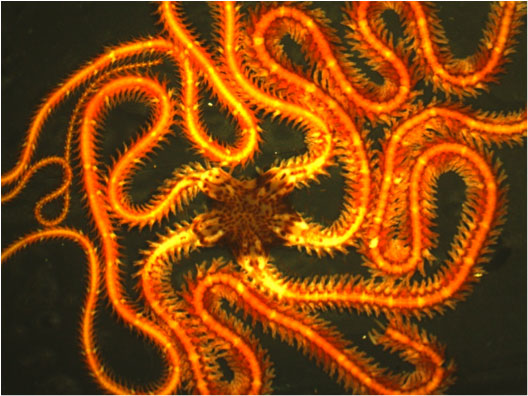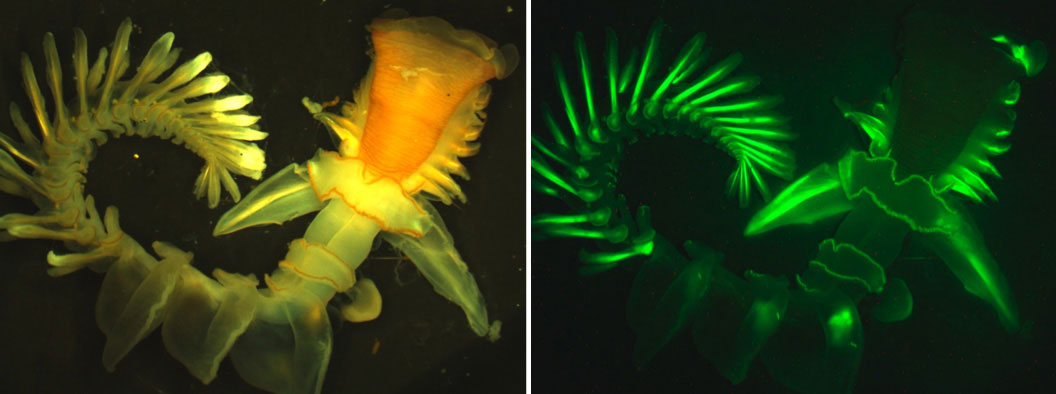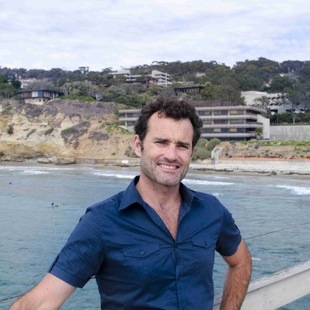| |
Do you believe in Tinker Bell? You remember, don’t you—Peter Pan’s fairy accomplice? In most performances she’s just a brilliant dot of light bouncing around the room. When Tinker Bell gets sick, though, when the children stop believing she exists, that light starts to fade. Only by believing in fairies can the audience bring back Tinker Bell’s strong glow.
Now, whether or not you believe in fairies, there are many animals around the world that glow like Tinker Bell. Fireflies are perhaps most famous for their light production. But most animals that glow are actually found in the oceans, where many fishes and other organisms first evolved such abilities. This ability of living organisms to produce visible light is known as bioluminescence. Like Tinker Bell, however, the strength of the light produced by these organisms can depend on the health of the individual—and the health of the environment in which the organism lives. In this way, the study of
bioluminescence
can serve as an indicator of environmental and population health. This is just one of the research topics of Dr. Dimitri Deheyn’s laboratory at the Scripps Institution of Oceanography at the University of California, San Diego.
The strength of the light produced by these organisms can depend on the health of the individual—and the health of the environment in which the organism lives.
Using marine organisms as ecological indicators of environmental health is a technique Dr. Deheyn has developed using bioluminescent brittlestars (a close cousin of starfish). This technique involves two sets of complementary experiments. First, healthy brittlestars raised in a breeding facility are transplanted in cages made of mesh-material to the environment whose health is being questioned. The brittlestars are monitored over time to see how they fare in the environment. Eventually some individuals are taken back to the laboratory where a special instrument known as a
luminometer
is used to measure the intensity and total amount of light they can produce. Second, healthy brittlestars in the laboratory are exposed to samples of water or sediment originating from the environment in question. These brittlestars are similarly monitored over time, and the researchers also measure the capacity of these organisms to produce light.

Brittle Star
Photo credit: Dmitri Deheyn, Scripps Institute of Oceanography
Each method has its own advantages and disadvantages, which is why they are complementary. In the first experiment, the natural environment exposes brittlestars to the many environmental variables that the experimenters cannot control. For example, temperature, salinity, pH, and many other properties of the water will all change together with the tide, the moon, and the level of ambient light. These may affect the brittle stars as will any pollution, thus making it difficult to determine the actual effects directly related to environmental pollution. In the laboratory, on the other hand, the researchers can more easily control the environment and make more accurate measurements though the environment is more controlled and simplified. Together, however, these two sets of experiments can be a good indicator of ecological health. “This is my way of creating a dialogue with individuals living in specific environments,” explains Dr. Deheyn. “It’s my way of asking them: how do you feel there? Do you feel stressed?”
Info from living animals
Bioluminescent organisms were first described more than a century ago and have since captured the imagination of everyone from scientists to Disney filmmakers. Bioluminescence is always the product of a chemical reaction between a substrate
protein
and an
enzyme.
The most well-known reaction is between the substrate
luciferin
and the enzyme
luciferase.
Luciferin and luciferase are generic names; they are used by fireflies as well as many other organisms to produce light. Luciferin and luciferases can have different chemical identities from one species to the other. However, in all species they do the same thing: produce light together. In all the bioluminescent organisms studied so far, the color of light is associated with the environment in which the organism lives: yellow-red for terrestrial environments, greenish in shallow-water environments, and bluish in deep-water environments. The color is an adaptation of the organism to the physical and chemical transmission properties of the air or water in which it lives and that will carry the produced light. This allows these specific colors to spread further in the environment. In addition, all the known chemical reactions to produce bioluminescence require oxygen, and the light they produce often occurs as short flashes, like that of fireflies.
"The color of light is associated with the environment in which the organism lives: yellow-red for terrestrial, greenish in shallow water and bluish in deep water."
The parchment tube worm – so different in so many ways
The parchment tube worm, however, challenges everything scientists have learned about bioluminescence so far. Living in the rather shallow bottom of the sea, the parchment tube worm glows blue where most other bioluminescent organisms glow green. And we aren’t talking bluish flashes of light but a strong steady glow that can last more than a day. Moreover, the glow is produced by mucus secreted by the worm in a chemical reaction that doesn’t use oxygen at the time of the light production. It is no wonder, then, that in recent years the parchment tube worm has become an important and curious research model for Dr. Deheyn.

Parchment tube worm – bright field (left) and fluorescent mode (right)
Photo credit: Dmitri Deheyn, Scripps Institute of Oceanography
Dr. Deheyn’s laboratory has been studying the bioluminescence of the parchment tube worm to understand the chemical reactions taking place. The first step was to separate the individual proteins in the mucus to determine which proteins were contributing to light production. To do this, Dr. Deheyn and his team used a filtration technique known as
chromatography.
Chromatography allows the researchers to separate proteins based on size, molecular charge, or other chemical properties.
Dr. Deheyn’s team filtered the mucus using chromatography over one hundred consecutive times to separate the individual proteins from the original “soup of proteins”. From this, they were able to identify three or four proteins that seem to always be required for light production. Surprisingly, one of these compounds was identified as riboflavin, or B12, a common ingredient in commercially available multivitamins. The researchers still do not know how these proteins work together to produce light, but hope to soon understand this unique process. Indeed, a more complete understanding of how the parchment tube worm produces light is an important area for future research in Dr. Deheyn’s laboratory.
Given the potential for bioluminescence as a tool for biotechnology and bioengineering, new light-producing compounds are in high demand. Dr. Deheyn hopes that the parchment tube worm could be used in the future as indicators for ecological health in deeper waters, just as brittlestars now do for coastal environments. “There is so much potential in marine biology ranging from ecology to bioengineering,” explains Dr. Deheyn. “We know so little about the sea, there is really so much more to learn.”
There is so much potential in marine biology. We know so little about the sea; there really is so much more to learn.
Dr. Deheyn is an Associate Research Scientist at the Scripps Institution of Oceanography at the University of California, San Diego. His research has been mainly funded by the Air Force Office of Scientific Research and involves the study of light production of marine organisms and its applications in fields ranging from health assessment of organisms under certain environmental conditions to bioengineering, biotechnology and biomedicine. Dr. Deheyn was born in the Belgian Congo (now Democratic Republic of the Congo), often traveling to Kenya where he would spend hours in the ocean snorkeling to watch coral reefs from a very young age, in lieu of TV or electronic games. Marine biology seemed a good fit given his love of the sea, his creative passions and his academic interests. When not in the laboratory, Dr. Deheyn enjoys spending time with his friends and family. He loves sports and enjoys a range of activities from yoga to running and rock climbing, or underwater hockey, which he plays at a highly competitive level.
To Learn More:
- Branchini, B. et al. 2014. “Chemical Analysis of the Luminous Slime Secreted by the Marine Worm Chaetopterus.” Photochemistry and Photobiology 90 (1): 247-251.
- Deheyn, D. et al. 2013. “Optical and Physicochemical Characterization of the Luminous Mucous Secreted by the Marine Worm Chaetopterus sp.” Physiological and Biochemical Zoology, 86(6): 702-715.
- Deheyn, D. and M. Latz. 2009. “Internal and secreted bioluminescence of the marine polychaete Odontsyllis phosphorea (Syllidae).” Invertebrate Biology, 128(1): 31-45.
- Deheyn D, Bencheikh-Latmani R, Latz MI (2004). Chemical speciation and toxicity of metals assessed by three bioluminescence-based assays using marine organisms. Environmental Toxicology 19: 161-178.
For More Information:
- The Bioluminescence Web Page Project. http://biolum.eemb.ucsb.edu/about.html Accessed March 7, 2014.
- How Bioluminescence Works. http://science.howstuffworks.com/zoology/all-about-animals/bioluminescence.htm Accessed February 5, 2014.
- Bioluminescence is the production and emission of light by a living organism. http://oceanservice.noaa.gov/facts/biolum.html Accessed February 5, 2014.
- Deheyn laboratory. https://scripps.ucsd.edu/profiles/ddeheyn
- Introduction to Bioluminescence. http://siobiolum.ucsd.edu/biolum_intro.html Accessed March 7, 2014.
Written by Rebecca Kranz with Andrea Gwosdow, PhD at www.gwosdow.com
HOME | ABOUT | ARCHIVES | TEACHERS | LINKS | CONTACT
All content on this site is © Massachusetts
Society for Medical Research or others. Please read our copyright
statement — it is important. |
|
|

Dr. Dmitri Deheyn

Nature’s Glowing Slime

Underwater hockey
Sign Up for our Monthly Announcement!
...or  subscribe to all of our stories! subscribe to all of our stories!

What A Year! is a project of the Massachusetts
Society for Medical Research.
|
|

